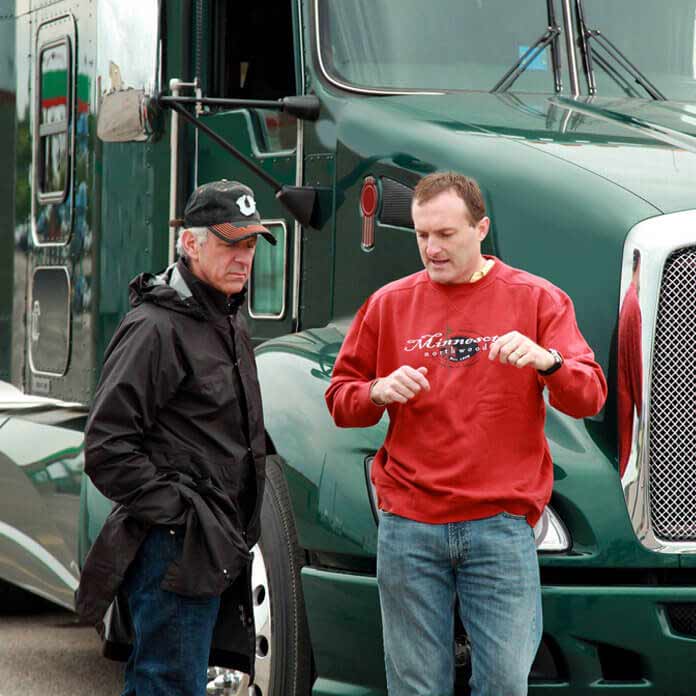Crashes involving commercial trucks are all too common in the United States and deaths involving tractor-trailer trucks have been increasing over the past several years. A common basis for truck accident lawsuits — including truck lawsuits filed by lawyers representing seriously injured motorists — continues to revolve around rear-end collisions.
That’s the fundamental reason transportation safety advocates are harping on the need for forward collision avoidance systems and speed limiting devices. Both technologies are in use by enlightened trucking outfits, but the National Transportation Safety Board (NTSB) and other highway safety watchdogs believe the devices should be standard on all commercial trucks.
“We believe that forward collision avoidance systems and speed limiting devices should be standard on all commercial trucks and have recommended that NHTSA (the National Highway Traffic Safety Administration) change the Federal Motor Vehicle Safety Standards to require them,’’ NTSB Member Christopher Hart told members of Congress last year in testimony.
Truck Lawyers Demand Safety
Leading truck accident attorneys Fred Pritzker and Eric Hageman side heavily with the NTSB. From what they’ve seen up close in their own 18-wheeler truck-trailer accident investigations, they are convinced that speed limiters and electronic avoidance systems would reduce deaths and decrease the severity of injuries when a passenger vehicle is rear-ended by a big company truck.
Contact Pritzker Hageman Law Firm for Help
Our Minnesota personal injury lawyers have won multimillion-dollar settlements for clients whose vehicles were rear ended by a commercial truck. Use the form below to find out how they can help you.
“There will always be trucking companies and fleet managers unwilling to invest voluntarily in highway safety,’’ said Eric Hageman, lead attorney in commercial truck accident litigation at Pritzker Hageman, P.A.
“The need for critical action couldn’t be more obvious,’’ Attorney Fred Pritzker said. “Make the systems mandatory now.’’
The Pritzker Hageman law firm is an award-winning, national resource assisting victims and family members suffering from trucking injuries, including the following brain trauma from a blow to the head, an amputation after suffering crushed legs or arms, blindness and other eye injuries, and a broken neck due to a C1, C2 or C3 fracture.
For Fred, Eric and highway safety advocates of all kinds, it’s a goal in 2018 to bring pressure to force the change and require the equipment. The movement is anchored by the NTSB, an independent federal agency charged by Congress with investigating aviation accidents and significant crashes in the highway, rail and marine sectors. The NTSB determines the probable cause of accidents and issues safety recommendations to prevent future accidents.
Finding Fault in Trailer-Truck Crashes
In 2015, the National Highway Traffic Safety Administration (NHTSA) found that drivers were the primary cause of 94 percent of highway crashes. The cause of driver error can vary from distraction to impairment, but most frequently, it is due to driver inattention. Collision-avoidance systems alert drivers to impending danger ahead or on the side of the vehicle
The NTSB investigates only a tiny fraction of fatal truck crashes in the United States. But driver inattention played a critical role in 11 crashes it investigated between 2012 and 2015. These crashes involved drivers failing to respond in time to obstacles ahead of them, and they resulted in 32 fatalities and 115 injuries. Some examples:
- On June 25, 2015, a truck-tractor in combination with a semi-trailer collided with the rear of several cars on Interstate 75 in a work-zone, near Chattanooga, Tennessee. Of the 18 vehicle occupants, six died and four were injured. The NTSB’s investigation determined the probable cause of the crash to be the truck driver’s fatigue, drug use, and excessive speed.
- On March 3, 2013, another tractor-trailer rig struck the rear of an SUV and pushed it into another passenger vehicle on Interstate 65, near Elizabethtown, Kentucky. A post-crash fire killed six of the SUV’s eight occupants. A review of the truck driver’s logbook indicated that he had driven beyond the legal hours of service and was likely fatigued at the time of the crash.
Fighting Read-End Truck Accidents
Hart, of the NTSB, told lawmakers that implementing collision avoidance technologies is one of the safety improvement issues on the agency’s current “Most Wanted List.” The technology helps compensate for fatigue, bad decisions, distracted driving and too much speed. The systems not only alert a driver to a potentially impending crash, but some systems activate emergency braking that automatically applies the brakes. For more than five years now, the NHTSA has been saying that the advanced emergency brakes on heavy trucks could prevent 500 to 700 serious injuries from rear-end crashes and as many as 65 lives per year.
The technology isn’t new. NTSB has been focused on moving collision avoidance systems into the U.S. trucking industry since the late 1990s.
Recommendations have come and gone without adequate rule changes even though a 2015 report by the NTSB found that collision avoidance technologies in passenger and commercial vehicles show clear benefits that could save lives. Now the NTSB is calling upon manufacturers to install forward collision avoidance systems as standard equipment on all new commercial trucks.
The agency also issued a Safety Alert for consumers and commercial fleet owners urging them to consider buying trucks with collision warning and autonomous emergency brakes. “Companies and commercial vehicle operators shouldn’t wait to be told what to do by regulators; they should install these technologies—at a minimum Forward Collision Warning Systems— in all their fleets,’’ the NTSB says on its Most Wanted List of Transportation Safety Improvements.
Recent Accidents
- A Minnesota family was rear ended by a semitrailer in Iowa. A mother and three of her children were seriously injured in the December 29, 2017, crash. One child, a 14-year-old son, was transported by air ambulance with a severe traumatic brain injury.
- A wreck involving a Kenworth and Freightliner truck killed both drivers. The preliminary investigation of the January 2018 collision found evidence that speed and weather conditions may be contributing factors.
